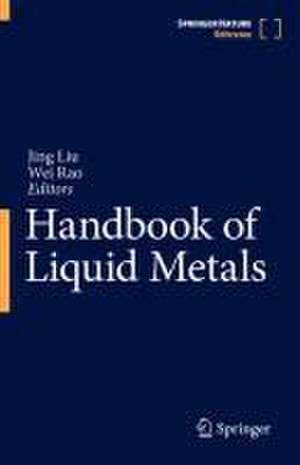Handbook of Liquid Metals
Editat de Jing Liu, Wei Raoen Limba Engleză Hardback – 6 dec 2024
This handbook presents comprehensive reference information on liquid metal science and technology that are currently available. The major advancements as made before are collected and summarized. Representative liquid metal applications are illustrated. It helps readers obtain a comprehensive understanding of the technical progresses and fundamental discoveries in the frontier, and thus better explore and utilize liquid metal materials to address various challenging needs.
Preț: 5495.78 lei
Preț vechi: 7137.39 lei
-23% Nou
Puncte Express: 8244
Preț estimativ în valută:
1051.59€ • 1100.91$ • 870.14£
1051.59€ • 1100.91$ • 870.14£
Carte nepublicată încă
Doresc să fiu notificat când acest titlu va fi disponibil:
Se trimite...
Preluare comenzi: 021 569.72.76
Specificații
ISBN-13: 9789819716135
ISBN-10: 9819716136
Pagini: 1500
Ilustrații: Approx. 1500 p. 1000 illus., 500 illus. in color.
Dimensiuni: 155 x 235 mm
Ediția:1st ed. 2024
Editura: Springer Nature Singapore
Colecția Springer
Locul publicării:Singapore, Singapore
ISBN-10: 9819716136
Pagini: 1500
Ilustrații: Approx. 1500 p. 1000 illus., 500 illus. in color.
Dimensiuni: 155 x 235 mm
Ediția:1st ed. 2024
Editura: Springer Nature Singapore
Colecția Springer
Locul publicării:Singapore, Singapore
Cuprins
Classical liquid metal.- Newly emerging liquid metal.- odification of liquid metal.- Material preparation and processing.- Nano liquid metal fabrication.- Engineering impact.- Surface tension of liquid metal.- Viscosity of Liquid Metal Flow.- Flow Dynamics of Liquid Metal.- Nano liquid metal fluidics.- Driving of liquid metal flow.- Microfluidics of liquid metal.- Thermal properties of liquid metal.- Phase change of liquid metal.- Thermal interface materials.- Analytical and computational heat transfer.- Advanced liquid metal cooling.- Liquid metal based heat recovery.- Oxidization of liquid metal.- Liquid Metal Catalysis.
Notă biografică
Prof. Jing Liu is a jointly appointed Professor of Tsinghua University (THU) and Technical Institute of Physics and Chemistry, Chinese Academy of Sciences (CAS). He received his double B.S. degrees in Engineering and Physics in 1992, and Ph.D. in 1996, all from THU and performed visiting researches at Purdue University and MIT. Dr. Liu works intensively at the interdisciplinary areas among liquid metal, biomedical engineering, and thermal science and pioneered a group of very fundamental discoveries in the area. His endeavors on liquid metal chip cooling, printed electronics, biomaterials, and soft machines initiated many game changing technologies which were frequently featured by worldwide science news. Dr. Liu’s inventions on hybrid freezing-heating tumor therapy machine and many mobile health care devices have led to diverse clinical uses. He is an author of fifteen popular books with one reprinted five times, over five hundred journal articles with over thirty selectedas cover story, and holds more than 200 granted invention patents. Dr. Liu is a recipient of numerous awards, including the William Begell Medal (issued to only an individual every four years), R&D 100 Awards Finalist, 2010-2011 Best Paper of the Year Award from ASME Journal of Electronic Packaging, CCTV 2015 Top Ten Figures in Science and Technological Innovation, and highest teaching award from CAS for six times, etc.
Textul de pe ultima copertă
This handbook systematically collects the latest scientific and technological knowledge on liquid metals obtained so far in this cutting edge frontier. Conventional materials such as metals, polymers, composites, ceramics and naturally derived matters, may not perform well when facing certain technological challenges. At around room temperature, most of such materials mainly stay at solid state and are often difficult to shape due to their high melting point. Meanwhile, although classical soft matters own good flexibility, their electrical conductivities including more behaviours appear not good enough which generally limited their utilizations. As a game-changing alternative, the room temperature liquid metal materials are quickly emerging as a new generation functional material which displayed many unconventional properties superior to traditional materials. Their outstanding versatile feature as “One material, diverse capabilities” is rather unique among existing materials and thus opens many exciting opportunities for scientific, technological and industrial developments.
This handbook presents comprehensive reference information on liquid metal science and technology that are currently available. The major advancements as made before are collected and summarized. Representative liquid metal applications are illustrated. It helps readers obtain a comprehensive understanding of the technical progresses and fundamental discoveries in the frontier, and thus better explore and utilize liquid metal materials to address various challenging needs.
This handbook presents comprehensive reference information on liquid metal science and technology that are currently available. The major advancements as made before are collected and summarized. Representative liquid metal applications are illustrated. It helps readers obtain a comprehensive understanding of the technical progresses and fundamental discoveries in the frontier, and thus better explore and utilize liquid metal materials to address various challenging needs.
Caracteristici
Outlines comprehensive fundamentals and practical advances in liquid metals Covers a diverse range of topics with potentially broad impacts on academia, industry, and society Provides numerous examples of how revolutionary materials are used to reshape modern science and technology
